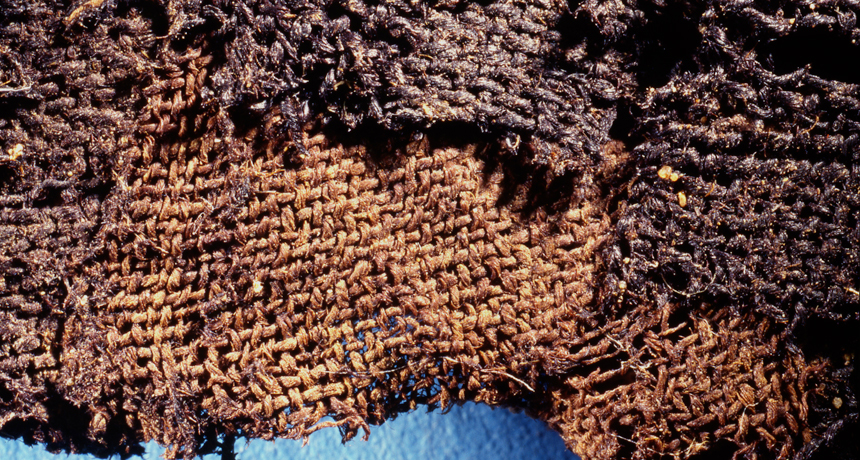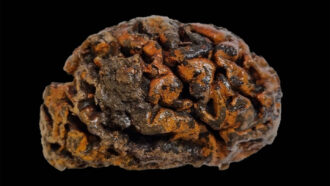Mummies existed before Egypt’s pyramids
Mummy-making in Egypt may have been common long before communities stored their dead in giant stone tombs

This fabric, more than 5,000 years old, was once coated with a mixture that scientists say was used to preserve dead bodies. That same mixture was used later by ancient Egyptian mummy-makers.
© RON OLDFIELD, J. JONES
Ancient Egyptians started building pyramids more than 4,500 years ago. By then, people were already preserving the dead as mummies. In fact, new research now suggests mummies may predate those giant stone tombs by at least 1,500 years.
That’s a conclusion scientists reached after analyzing samples from two Egyptian cemeteries. Those samples — which may be more than 6,000 years old — included fragments of linens and human skin.
Archaeologist Jana Jones works at Macquarie University in Sydney, Australia. Her team’s newly analyzed samples came from a prehistoric community that farmed and raised animals in the land between the Red Sea and the Nile River. These people wrapped their dead in linens. But first, they soaked that fabric in a mix of oils and resin, a sticky substance from plants.
Thousands of years later, Egyptians used much the same mix to mummify bodies that they placed in the pyramids, Jones’ group notes. The team reported its findings August 13 in PLOS ONE.
Embalming a dead body protects it from decay. In addition to resin and oils, the ancient mixture used to mummify bodies also may have included sugar and wax. Those substances would have helped preserve the bodies, the scientists say.
Jones and her co-workers are challenging a popular notion about the origins of mummies. Many researchers had suspected that the ancient Egyptians began preserving their dead after observing that bodies left in the desert did not decay. The extreme heat dried them. But the new study suggests instead that mummy-making began with wrapping bodies in resin-soaked cloth.
Mummies in the ancient cemetery weren’t exactly like those stored in the pyramids. The more ancient bodies still had their internal organs intact. Before mummies were placed in the pyramids, burial crews first removed their internal organs, dried them and wrapped them in linen. Then they placed these packages back into the bodies.
Not all scientists agree that the new findings mean scientists have to rethink the origins of mummies. Donald Redford is one of those skeptics. An archaeologist at Pennsylvania State University in College Station, he says Jones’ team doesn’t know why the ancient community shrouded its dead in linens treated with the oil-and-resin mix. The treatment could have had another purpose than preserving the bodies.
The earliest confirmed efforts to preserve bodies date back only about 4,600 years ago. That’s around the time when the first pyramids were built, he says. He told Science News: “I know of no other evidence that embalming had even dawned on the thinking of Egyptians” before that time.
Power Words
archeology The study of human history, performed by analyzing things that ancient humans left behind, from housing materials and cooking vessels to clothing and footprints. People who work in this field are known as archeologists.
embalm To preserve a corpse from decay, initially using plant or animal materials. Today, burial specialists usually inject a chemical preservative into the corpse’s arteries to protect the dead tissue from decay.
linen Cloth woven from flax.
pyramid A monumental structure with a square or triangular base and sloping sides that meet in a point at the top. The best known are those made from stone as royal tombs in ancient Egypt.
resin A sticky, sometimes aromatic substance, often secreted by plants. It also may be the viscous starting ingredient for some plastics that will harden when heated or treated with light.







